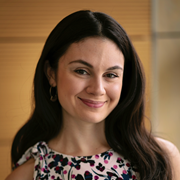
Laura Baehr
Biography
Laura Baehr is a clinician-scientist and educator who is committed to improving movement access and equity for individuals with disabilities and chronic health conditions. She uses her interdisciplinary training as a scientist and artist to center evidence-based health promotion on the lived experience of the individual. She completed her PhD in health and rehabilitation science at Drexel University, her doctor of physical therapy from Temple University, and dual bachelor of art and science in dance and neuroscience from Muhlenberg College.
Laura is a co-investigator on a non-randomized clinical trial funded by both the Craig H. Neilsen Foundation and the Pennsylvania Department of Health investigating the impact of a novel group tele-exercise program for individuals with chronic spinal cord injury on psychosocial factors and physical activity behavior. She specializes in community-engaged research strategies and mixed methodology. Her teaching philosophy is grounded by curiosity, connection and equity. She believes that student engagement is fostered through mutual respect and reciprocal learning. Laura encourages clinicians-in-training and undergraduates to integrate these same principles. Her approach to education is implemented in the community as well as the classroom.
For over 10 years she has taught regionally and nationally as an adapted movement instructor informed by mind-body practices including dance, pilates and yoga. She has teaching appointments at the Pennsylvania Center for Adapted Sports and as an inaugural OnDemand fitness instructor for Move United, a national adapted sports organization. She also serves as the American Physical Therapy Association Qualitative Research Special Interest Group post-professional liaison and is a member of the Disability Justice and Anti-Ableism Catalyst Group. She has been invited to share her work in both academic and community settings including annual meetings of the American Spinal Injury Association, the American Physical Therapy Association, the American College of Sports Medicine, the National Dance Education Organization as well as Columbia University, Alvernia University, and Adaptive Sports Northwest.
Education
- PhD, Health and Rehabilitation Science, Drexel University
- DPT, Temple University
- BA/BS, Dance and Neuroscience, Muhlenberg College
Courses Taught
|
Number |
Name |
Level |
|---|---|---|
|
PHTH 8103 |
Clinical Examination and Intervention Skills I |
Graduate |
|
PHTH 8121 |
Clinical Electrophysiology and Biophysical Agents |
Graduate |
|
PHTH 8137 |
Evidence Based Practice II |
Graduate |
|
PHTH 8161 |
Integrated Clinical Experience 1 |
Graduate |
|
PHTH 8162 |
Integrated Clinical Experience 2 |
Graduate |
|
PHTH 8163 |
Integrated Clinical Experience 3 |
Graduate |
|
PHTH 8164 |
Integrated Clinical Experience 4 |
Graduate |
|
PHTH 8165 |
Integrated Clinical Experience 5 |
Graduate |
Selected Publications
-
Carey, R.L., Le, H.a., Coffman, D.L., Nahum-Shani, I., Thirumalai, M., Hagen, C., Baehr, L.A., Schmidt-Read, M., Lamboy, M.S.R., Kolakowsky-Hayner, S.A., Marino, R.J., Intille, S.S., & Hiremath, S.V. (2024). mHealth-based just-in-time adaptive intervention (JITAI) protocol to improve physical activity levels of individuals with spinal cord injury (Preprint). JMIR Publications Inc. doi: 10.2196/preprints.57699
-
Baehr, L.A., Hiremath, S.V., Bruneau, M., Chiarello, L.A., Kaimal, G., Newton, R., & Finley, M. (2024). Effect of Tele-exercise to Promote Empowered Movement for Individuals With Spinal Cord Injury (TEEMS) Program on Physical Activity Determinants and Behavior: A Mixed Methods Assessment. Arch Phys Med Rehabil, 105(1), pp. 101-111. United States. doi: 10.1016/j.apmr.2023.08.019
-
Baehr, L.A., Kaimal, G., Bruneau, M., & Finley, M. (2023). Development and Feasibility of a Group Tele-Exercise Program for Individuals With Spinal Cord Injury. J Neurol Phys Ther, 47(4), pp. 200-207. United States. doi: 10.1097/NPT.0000000000000449
-
Baehr, L.A., Fisher, K., & Finley, M. (2023). Perspectives on Health With Spinal Cord Injury Now and in the Future: A Qualitative Descriptive Study. Phys Ther, 103(4). United States. doi: 10.1093/ptj/pzad011
-
Baehr, L.A., Frey-Law, L.A., & Finley, M. (2022). Quantitative Sensory Changes Related to Physical Activity in Adult Populations: A Scoping Review. Am J Phys Med Rehabil, 101(7), pp. 708-713. United States. doi: 10.1097/PHM.0000000000001883
-
Baehr, L.A., Kaimal, G., Hiremath, S.V., Trost, Z., & Finley, M. (2022). Staying active after rehab: Physical activity perspectives with a spinal cord injury beyond functional gains. PLoS One, 17(3), p. e0265807. United States. doi: 10.1371/journal.pone.0265807
-
Finley, M., Baehr, L., Jr., M.B., & Kaimal, G. (2021). Group Tele-exercise for Individuals with Spinal Cord Injury: A Mixed Methods Pilot Study. Journal of Physical Activity Research, 7(1), pp. 10-17. Science and Education Publishing Co., Ltd.. doi: 10.12691/jpar-7-1-3
-
Finley, M., Euiler, E., Baehr, L., Gracely, E., Brownsberger, M., Schmidt-Read, M., Frye, S.K., Kallins, M., Summers, A., York, H., & Geigle, P.R. (2021). Relationship of psychosocial factors and musculoskeletal pain among individuals with newly acquired spinal cord injury. Spinal Cord Ser Cases, 7(1), p. 61. England. doi: 10.1038/s41394-021-00415-4
